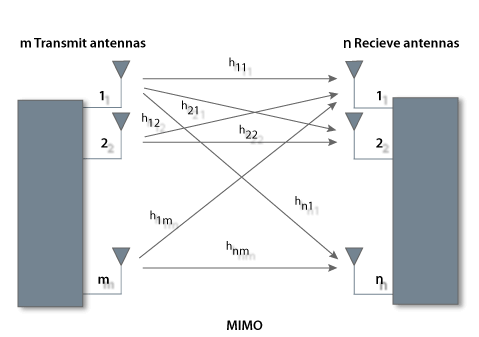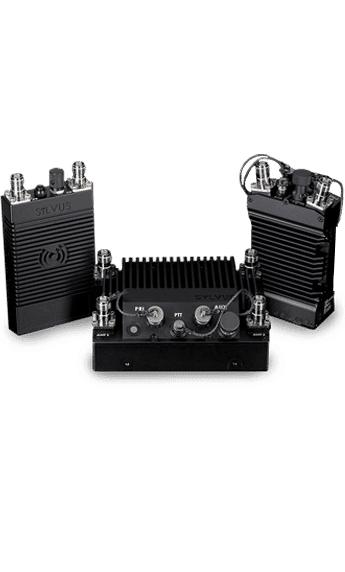Introduction to MIMO
Introduction to MIMO
Multiple antennas for both transmitters and receivers vastly improve communication performance
Many modern telecommunications standards, particularly in the consumer space, have adopted multiple antenna (MIMO) technology because of the significant advantages it provides over similar system utilizing single antenna transceivers (SISO).

MIMO stands for Multiple-In Multiple-Out, referring to the fact that when a packet is transmitted into the channel it transmitted on more than one antenna and when it comes out of the channel it is received on multiple antennas. This is in contrast to a Single-In Single-Out system with one antenna on both ends of the link, or a SIMO system which would include some types of radios that use diversity combining at the receive end but still transmit over only a single antenna.

Some may find the notation a bit odd since when the names were originally coined at Bell Labs they were done from the perspective of the channel rather than the radio, with “in” referring to the transmit function.
What is multiple antenna technology?
Multiple antennas at the transmitter and receiver introduces signaling degrees of freedom that were absent in SISO systems. This is referred to as the spatial degree of freedom. The spatial degrees of freedom can either be exploited for “diversity” or “multiplexing” or a combination of the two. In simple terms, diversity means redundancy.
A simple example of diversity is multiple antennas trying to receive the same signal. The received signal on the two antennas is corrupted by noise that is uncorrelated between antennas, therefore by combining the two signals a better quality signal can be reconstructed. The analogy here is that by looking at the same object from two different vantage points, richer information on the object can be obtained. Diversity can also be achieved using multiple transmit antennas by using Space Time Coding (STC) techniques.
The second major MIMO technique is Spatial Multiplexing. Spatial multiplexing enables a MIMO transmitter/receiver pair to increase its throughput without increasing bandwidth usage or transmit power. Multiplexing increases throughput linearly with the number of transmit or receive antennas, whichever is lower. The transmitter sends signals carrying different bit streams from each of its antennas. Each receiver antenna receives a linear combination of the transmitted signals. The wireless channel is a matrix that is a function of transmit/receive antenna array geometry and the scatters/reflectors present in the environment.
When a MIMO transmitter/receiver pair operates in an environment rich in scattering, the channel matrix becomes invertible, thus enabling the receiver to decode all the different signals transmitted from the various transmit antenna apertures, resulting in multiplexing gain. There is a trade off between the amount of diversity and multiplexing gain a MIMO system can provide. A typical MIMO transmitter/receiver pair automatically finds an operating point on the diversity-multiplexing trade off curve based on instantaneous wireless channel conditions.

Techniques of MIMO:
Eigen-Beamforming
Eigen-Beamforming can be done at both the transmit side of a link and the receive side. Classical Beamforming is like using a high gain antenna, but one that need not be reoriented to point in different directions, Eigen-Beamforming achieves the same gain but is insensitive to antenna orientation or scattering elements in the vicinity of the antenna. Many people think of systems like phased-array radar when the idea of beamforming is introduced, and indeed, phased-array is a method of using multiple antenna elements to steer the directivity of the antenna cluster in different directions, forming a transmit or receive antenna “beam”.
Despite “phased-array” having a seemingly advanced air to it due to its use in extremely expensive military systems, it is actually a simpler form of beamforming than can be done with a modern MIMO system. Phased-array systems perform their beamforming using limited capability of phase shifting and combining of signals in the analog domain, which has some significant drawbacks including the fact that the performance benefit degrades as the channel bandwidth is increased and that it generally works only in pure line of sight (LOS) situations in the absence of any scatterers or multipath which cause significant degradation.
MIMO Eigen-beamforming on the other hand, converts the signals from all of the antennas into the digital domain where sophisticated Digital Signal Processing (DSP) can be used. Eigen-beamforming can thus in effect be done independently for each of the narrowband subcarriers of an Orthogonal Frequency Division Multiplexing (OFDM) system. In particular, MIMO systems can utilize a type of beamforming known as Eigen beamforming. Eigen beamforming is not limited to forming a simple beam in three-dimensional space. It is not adversely affected by scattering objects or multipath reflections. An Eigen beamformer receiving a signal in a non-line-of-sight (NLOS) situation with multiple reflections may form an effective antenna pattern that increases gain in multiple directions corresponding to the individual reflections. Using Digital Signal Processing, MIMO systems have the ability to adapt these patterns on a packet-by-packet basis.
Space-Time Coding
Space-time coding is a mechanism that can be utilized to transmit over multiple antennas and achieve similar gains as can be achieved using multiple antenna diversity reception. Space-time coding means taking the data that would ordinarily be transmitted from a single antenna and applying a signal processing coding technique in order to transmit a mathematically altered version of the same information content on additional antennas in a way that enhances the ability of the receiver to separate the data from the background noise. Space-time coding can be a natural match to receive beamforming or diversity reception.
Take a situation for example where a vehicle-mounted radio can easily have four antennas whereas a small handheld unit might be limited to two or even one antenna. If the handheld is transmitting on a single antenna, the vehicle unit can use receiver diversity or beamforming to improve the reception. Space-time coding gives the vehicle a way to transmit on all four antennas and achieve a similar gain when the handheld is limited to a single receive antenna, thus making the link symmetrical and much more useful for bidirectional communication.
Spatial Multiplexing
Spatial Multiplexing is often the technique that people find difficult to believe, let alone grasp. This MIMO technique actually transmits multiple unique information “streams” from different antennas, each operating at an identical center frequency. A receiver using at least as many antennas as the number of streams transmitted can decode these individually and thus increase the amount of data flowing through a fixed channel bandwidth. A 4×4 MIMO system can achieve four streams under optimal conditions and thus transmit four times as much data as a SISO system over the same channel bandwidth.
If we have a transmitter that is transmitting four streams (A, B, C and D), these streams merge in the air and a garbled combination of wA+xB+yC+zD arrives at each of the four receive antennas, where w, x, y and z represent the channel distortions caused by a multipath-rich channel that vary at each antenna. It is through very sophisticated MIMO Digital Signal Processing that the receiver characterizes all these w, x, y, z channel effects in order to recover the original A, B, C and D streams by doing what amounts to solving four equations with four unknowns that many may remember from linear algebra classes.
MIMO spatial multiplexing has the benefit of being able to increase spectral efficiency (bits per sec per Hz of channel) without decreasing the robustness of the link as much as going to higher-order constellations. For instance, close to 4 bits/sec/Hz can be achieved with 16-QAM with a fairly robust FEC coding rate by utilizing two streams. Without MIMO, a system would need to utilize 64-QAM and a less robust FEC coding rate in order to achieve similar throughput within the same channel–greatly limiting its range or requiring much higher transmit power.
All these techniques, whether utilized individually or in some combination, provide benefits that can be measured in terms of lower required transmit power, greater range, more noise immunity or higher throughputs.
WE DON’T JUST CLAIM SUPERIORITY. WE PROVE IT.
Not only do we build superior technology, we help you get the most from it. Out-of-the-box functionality. Ongoing support. Relentless research and development. Contact our sales team to discover how we’re leading the MIMO revolution.



